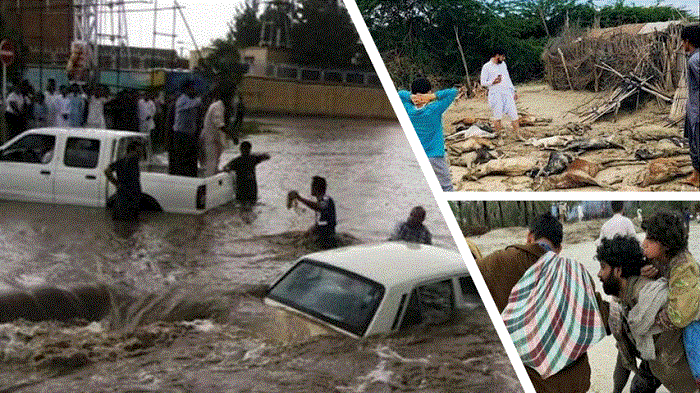
Heartbreaking scenes from the destructive flood in Baluchistan
By Jennifer Jones-Kelley
Deadly floods in Sistan and Baluchestan Province in Iran have claimed at least four lives and displaced thousands since heavy rains overwhelmed the impoverished southeastern province’s failing dams and infrastructure in early January. More than two weeks later, locals are still waiting for government aid, including potable water, food, and shelter.
Discrimination and Neglect
Sistan and Baluchestan Province is known as a deprived area in a country in which 80 percent of the population lives below the poverty line. Many Baluchis live in mud or clay huts, and homelessness is rampant. The Iranian regime has neglected the province’s infrastructure, leaving roads, bridges, and dams to crumble.
The neglect of Sistan and Baluchestan Province is due to the Baluchis’ status as religious minorities. As Sunni Muslims, Baluchis are subject to discrimination, including denial of legal representation and discrimination in higher education. The MEK Iran political platform prohibits religious discrimination and has taken a strong stance against the persecution of Baluchi minorities.
It has been almost two weeks that floods have stricken the deprived province of Sistan and Baluchestan, southeast Iran, with an estimated damage of over one billion dollars.#Iranhttps://t.co/3x2fixSPH8
— People's Mojahedin Organization of Iran (PMOI/MEK) (@Mojahedineng) January 23, 2020
Regime President Hassan Rouhani waited eight days after the onset of the floods to visit the devastated province, where he was greeted with anger for his government’s refusal to provide assistance to flood victims or take any action to prevent the damage.
One local resident told Rouhani: “There are no water purification centers here, no plumbing. Whatever facilities there are were built thirty years ago.”
Alligators and Treetop Refuges
The deadly floods have wreaked havoc on southern Iran, but Sistan and Baluchistan Province have been hit the hardest. Rising floodwaters brought alligators into inhabited areas, terrifying flood victims. Some locals have been forced to sleep in trees to escape high floodwaters. Temperatures have dropped below freezing in some areas, and heavy mist and snowfall have been reported.
The floods in southern Iran have caused an estimated $1 billion in damages. 40 percent of houses in Sistan and Baluchestan Province were completely destroyed, and another 20,000 suffered significant damage. The agriculture industry, which provided the bulk of employment in the province, suffered $100 million in damages, due to heavy flooding of fields and cattle deaths. 80 percent of residents are still without potable water.
Corruption and Inaction
While the people of Sistan and Baluchestan Province freeze in treetops, the corrupt regime spends millions funding terrorist proxies in the region and providing lavish lifestyles for members of the Revolutionary Guards (IRGC), who control half of the country’s economy. Regime Supreme Leader Ali Khamenei has refused to allow the Majlis (Parliament) to divert money from the National Development Fund for flood recovery efforts but granted a recent request for $220 million from the fund to be diverted to the terrorist Quds Force.
The #MEK has been instrumental in drawing attention to the regime’s corruption and mismanagement of mechanisms designed to mitigate #IranFloods damage.
Read More:https://t.co/czLVKDSy0g #IranFlood #FreeIran— MEK Iran (Mujahedin-e Khalq) (@MEK_Iran) March 29, 2019
After floods devastated Iran last year, the MEK Iran led protests against the regime’s failure to provide assistance to flood victims. MEK Iran Resistance Units and members of the public rushed to the aid of their fellow Iranians in the absence of government aid, despite orders from the regime not to assist their friends and neighbors. Regime officials, who claimed that they did not have the resources to provide a swift response to stranded flood victims, promptly deployed tanks and military troops to suppress protests by angry flood victims who had lost their homes and relatives in the deadly floods and were still waiting on tents and food.
A Preventable Tragedy
The regime’s inaction in the aftermath of the floods is shameful but equally disgraceful is the fact that the majority of the damage resulting from the floods could have been prevented. On January 18, the state-run Resalat newspaper reported: “The General Manager of Meteorology has emphasized that they time and again warned authorities about the overflow of dams in numerous discussions and Crisis Management sessions, but unfortunately, the local Water Organization did not take them seriously to empty dams’ capacities. The result was the overflow of four dams.”
The state-run Khabar Fori website also acknowledged the regime’s culpability in the flood damage in a January 20 article, writing, “Analysis shows that overflow of four dams in flood-affected areas of Sistan and Baluchestan and the negligence in watershed management projects played a major role in the damage increase.”
According to a regime official, High Council of Provinces quoted in the article, a simple repair of the region’s dam could have prevented 70 percent of the damages. “In 2007-2008, the Guno Storm destroyed the region’s dam. While the dam could be reconstructed in a week, the government has not repaired it after 13 years,” said Shahbakhsh Goorgij.
